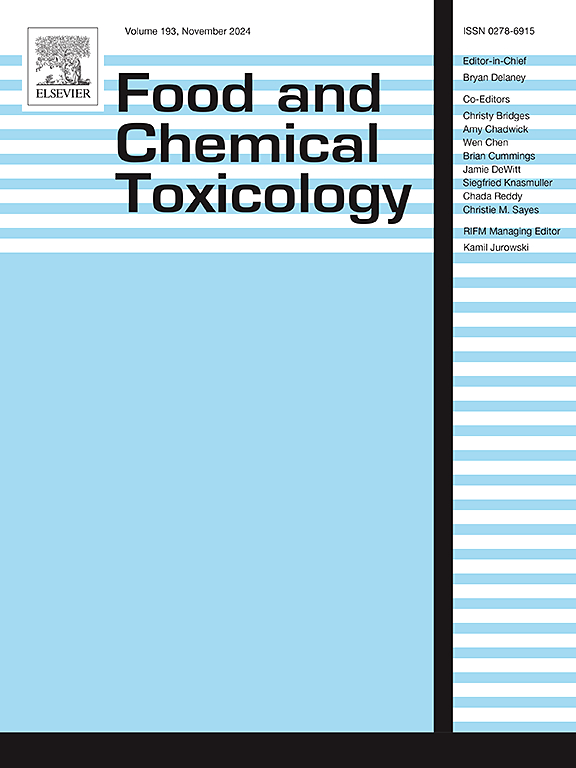Is the potential for bioaccumulation of cannabinoids underestimated? Insights from biomimetic chromatography in cannabinoid exposure evaluation
IF 3.9
3区 医学
Q2 FOOD SCIENCE & TECHNOLOGY
引用次数: 0
Abstract
The use of cannabis-related products is currently experiencing extraordinary growth in popularity in the European and US markets. A wide variety of cannabis-related products have emerged, including oils, tinctures, edibles, topicals, cosmetics, and even beverages and sweets, offering the purported medical benefits without the psychoactive effects associated with Cannabis sativa. However, there is a significant gap in our understanding of bioaccumulation processes and their long-term effects, particularly as cannabinoids are highly lipophilic molecules. In this study, we used a biochromatographic approach to experimentally determine the lipophilicity, binding to phospholipids and affinity to plasma protein of selected cannabinoids to comprehensively assess their bioaccumulation potential. The results obtained clearly indicated that cannabinoids, including the particularly popular cannabidiol, promote bioaccumulation. Importantly, a higher affinity for phospholipids indicated non-specific binding, which can lead to phospholipidosis. Cannabinoids exhibit a stronger binding affinity to human serum albumin (HSA) compared to diclofenac, which might affect the pharmacokinetics of regularly taken medications when co-administered.
大麻素的生物积累潜力被低估了吗?大麻素暴露评价中仿生色谱的见解。
大麻相关产品的使用目前在欧洲和美国市场的受欢迎程度正在显著增长。各种各样的大麻相关产品已经出现,包括油、酊剂、食品、外用药物、化妆品,甚至饮料和糖果,提供了所谓的医疗效益,而没有与大麻相关的精神活性作用。然而,我们对生物积累过程及其长期影响的理解存在重大差距,特别是大麻素是高度亲脂分子。在本研究中,我们采用生物色谱方法实验测定了所选大麻素的亲脂性、与磷脂的结合以及与血浆蛋白的亲和力,以综合评估其生物蓄积潜力。获得的结果清楚地表明,大麻素,包括特别流行的大麻二酚,促进生物积累。重要的是,对磷脂的高亲和力表明非特异性结合,这可能导致磷脂病。与双氯芬酸相比,大麻素与人血清白蛋白(HSA)的结合亲和力更强,这可能会影响定期服用药物的药代动力学。
本文章由计算机程序翻译,如有差异,请以英文原文为准。
求助全文
约1分钟内获得全文
求助全文
来源期刊

Food and Chemical Toxicology
工程技术-毒理学
CiteScore
10.90
自引率
4.70%
发文量
651
审稿时长
31 days
期刊介绍:
Food and Chemical Toxicology (FCT), an internationally renowned journal, that publishes original research articles and reviews on toxic effects, in animals and humans, of natural or synthetic chemicals occurring in the human environment with particular emphasis on food, drugs, and chemicals, including agricultural and industrial safety, and consumer product safety. Areas such as safety evaluation of novel foods and ingredients, biotechnologically-derived products, and nanomaterials are included in the scope of the journal. FCT also encourages submission of papers on inter-relationships between nutrition and toxicology and on in vitro techniques, particularly those fostering the 3 Rs.
The principal aim of the journal is to publish high impact, scholarly work and to serve as a multidisciplinary forum for research in toxicology. Papers submitted will be judged on the basis of scientific originality and contribution to the field, quality and subject matter. Studies should address at least one of the following:
-Adverse physiological/biochemical, or pathological changes induced by specific defined substances
-New techniques for assessing potential toxicity, including molecular biology
-Mechanisms underlying toxic phenomena
-Toxicological examinations of specific chemicals or consumer products, both those showing adverse effects and those demonstrating safety, that meet current standards of scientific acceptability.
Authors must clearly and briefly identify what novel toxic effect (s) or toxic mechanism (s) of the chemical are being reported and what their significance is in the abstract. Furthermore, sufficient doses should be included in order to provide information on NOAEL/LOAEL values.
 求助内容:
求助内容: 应助结果提醒方式:
应助结果提醒方式:


